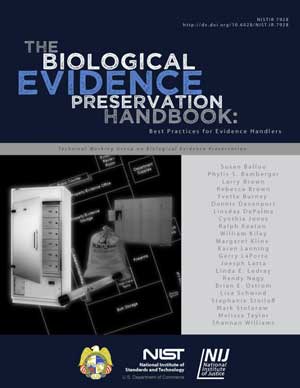Biological Evidence Preservation Handbook
Best Practices for Evidence Handlers
Technical Working Group on Biological Evidence Preservation

INTRODUCTION
Across the nation, headlines tell the story of evidence that has been mishandled, misplaced, lost, or destroyed. Often the blame for these mishaps is directed toward property and evidence custodians housed in law enforcement agencies nationwide. Many law enforcement agencies do not properly address, recognize, or support the efforts of their property rooms. Although these agencies bear ultimate responsibility for maintaining the integrity of the evidence, the real problem lies with a systemic failure to properly account for evidence from collection through final disposition. This failure reduces the public's confidence in the criminal justice system to produce just results in criminal and civil proceedings.
Biological evidence refers to samples of biological material—such as hair, tissue, bones, teeth, blood, semen, or other bodily fluids—or to evidence items containing biological material (DNA Initiative 2012). This biological evidence, which may or may not have been previously analyzed at a forensic laboratory, should be retained in an appropriate storage facility until needed for court or for forensic testing. Such evidence is frequently essential in linking someone to or excluding someone from crime scene evidence. The criminal justice system depends on presenting evidence to judges and jurors to help them reach a conclusion about the guilt or innocence of the defendant. All criminal justice stakeholders, including law enforcement officers, lawyers, forensic analysts, and fact finders, should be certain that the biological evidence they are considering has been properly preserved, processed, stored, and tracked to avoid contamination, premature destruction, or degradation. In addition, individuals who come into contact with biological evidence, such as evidence custodians, need to be confident that it has been packaged and labeled in a way that will allow them to efficiently locate relevant evidence for a case. To establish this confidence, all handlers of biological evidence should follow well-defined procedures for its optimal preservation.
The Biological Evidence Preservation Handbook offers guidance for individuals involved in the collection, examination, tracking, packaging, storing, and disposition of biological evidence. This may include crime scene technicians, law enforcement officers, healthcare professionals, forensic scientists, forensic laboratory managers, evidence supervisors, property managers, storage facility personnel, lawyers, testifying experts, court staff members, and anyone else who may come in contact with biological evidence. While many of the recommendations relate to the physical storage, preservation, and tracking of evidence at the storage facility, this handbook also covers the transfer of the material between the storage facility and other locations and discusses how the evidence should be handled at these other locations.
This report is divided into five main sections that detail issues and make recommendations related to biological evidence storage, tracking, preservation, and disposition. A glossary, which provides standard definitions of the technical terms used in this report, follows these sections.
RETAINING BIOLOGICAL EVIDENCE
While most states have established their own statutes and/or policies for biological evidence retention, some have not. It is imperative that high-level guidance be given to biological evidence handlers regarding the circumstances under which evidence must be kept. This section defines recommended best practices for retaining biological evidence, including the length of time such evidence should be kept. It also provides guidance on identifying what biological evidence should be retained.
BIOLOGICAL EVIDENCE HAZARDS AND HANDLING
Contact with bodily fluids can spread disease such as those caused by bloodborne pathogens, and individuals handling biological evidence should treat it as hazardous to ensure safety. This section offers recommendations on various aspects of biological evidence handling, including the use of personal protective equipment (PPE), Federal standards, the management of spills or accidents, and biological waste disposal.
PACKAGING AND STORING BIOLOGICAL EVIDENCE
The use of well-defined procedures for packaging, storing, and tracking can maintain biological evidence integrity for testing. Personnel involved in managing biological evidence often face challenges because of the size and location of the storage facility, supplies available for packaging, adequacy of tracking systems and resources, and other issues. This section identifies current best practices to maintain evidence integrity from initial packaging to final disposition.
CHAIN OF CUSTODY AND EVIDENCE TRACKING
Providing an accurate and complete chain of custody record ensures that the evidence that arrives in court is what was collected at the crime scene. An accurate chain of custody identifies and tracks the evidence from the time it was collected—including the method by which it was obtained—through final disposition for each individual who had possession and responsibility. This section discusses various evidence tracking systems and recommends procedures to improve all aspects of chain-of-custody recordkeeping.
EVIDENCE DISPOSITION
Jurisdictions face limitations because of storage space and preservation requirements and must make choices about when to keep or how to dispose of certain evidence. This section makes recommendations for best practices, policies, and procedures to decide what evidence needs to be retained and the length of time it needs to be retained in accordance with applicable statutes.
TECHNICAL WORKING GROUP ON BIOLOGICAL EVIDENCE PRESERVATION
The recommendations in this document are not mandated by any governing body; they are provided as recommended best practices developed and agreed upon by the Technical Working Group on Biological Evidence Preservation. This working group consists of experts in all aspects of biological evidence preservation (see following list) who have devoted time to researching and documenting the best advice that current technology allows.

